Resistance bands may look flimsy and unassuming, but you’d be mistaken to let their unassuming looks deceive you. Numerous studies have proven that resistance bands are effective to build strength, and this post explains why it’s possible and as well as to do it!
Resistance bands can be used to increase strength by performing low repetitions using a heavy tension. It is recommended to perform 5-6 reps per set and no more than 5 sets per muscle group per workout. Progressive overload should also one applied by increasing weight over time.
Not only will I teach you how to get stronger using resistance bands, but I’ll also share an example strength workout you can try!
So what are you waiting for?
Keep reading to find out!

- Recommended Resistance Bands For Strength Training
- What Is Strength And How Do You Get Stronger?
- Can Resistance Bands Build Strength?
- Why Resistance Bands Are An Effective Form Of Strength Training
- How To Increase Strength Using Resistance Bands
- Resistance Band Strength Workout Example
- Can Resistance Bands Build Strength Like Weights?
- Why The Undersun Bands Are Ideal For Strength Workouts
- Conclusion
Recommended Resistance Bands For Strength Training
Here is the first (and probably the most important) advice you should realize about strength training:
“If you want to get strong, [you need to] lift heavy for just a few reps”
Michael Rodio, PT, Mens Journal
So it makes sense that you need heavy resistance bands to build strength, right?
Well, that’s exactly what the bands from Undersun Fitness are.
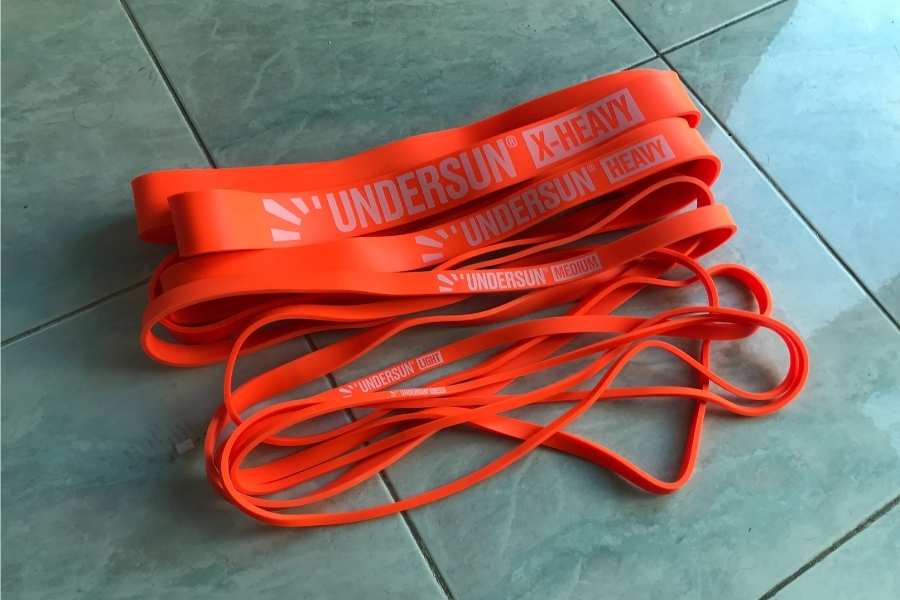
They’re a set of 5 bands that go from extra light to extra heavy. That means you have enough resistance for taking you from the beginner stages of strength training to the intermediate-advanced stages.
That’s at least 2-4 years of strength progression!
And my favorite thing about them other than their affordable price?
They’re the most durable bands I’ve used! And I’ve tested a half dozen…
Each set comes with a lifetime warranty which no other competitor offers to the best of my knowledge.
If you’re interested, you can find my full thoughts on the Undersun bands here.
What Is Strength And How Do You Get Stronger?
Strength refers to the ability to overcome resistance. Put simply, it describes how effectively a person can use their muscles to generate force to push or pull on an object. Getting stronger requires the lifting of progressively heavier weights over time.
As the guys from Barbell Logic explain, the easiest way to understand what strength is to think of it as how much force you can produce.
If Person A can lift a heavier resistance (weight) than Person B, then the former is stronger than the latter.
Using resistance band strength training to become stronger is not all too dissimilar to using weights.
Generally speaking, the training methods used to build strength are similar to the methods used to build muscle size, but with slight variations in the rep range.
To effectively build strength, you should lift in a low rep range (around 4-6 reps per set) using a weight that challenges you for those reps.
Additionally, it’s also essential that you regularly apply progressive overload.
This requires you to increase intensity over time by adding more weight (i.e using a heavier resistance band) every 1-3 weeks.

I like to combine multiple bands to create bigger resistance and keep getting stronger if I’ve outgrown the individual bands!
Can Resistance Bands Build Strength?
Resistance bands are an effective way to build strength. However, just like with weight training, it is essential to use a challenging band tension for the allotted reps and to also increase tension over time. This encourages the muscle to get stronger.
On a wider level, resistance bands have many benefits in terms of training results.
But one of these benefits, in particular, is unique to resistance bands.
They have a unique force profile that makes them ideal for making strength gains.
I’ll explain what a “force profile” means next.
But for now, it’s important to acknowledge that resistance bands are an effective way to build strength.
This has been shown in scientific studies as well as various online case studies.
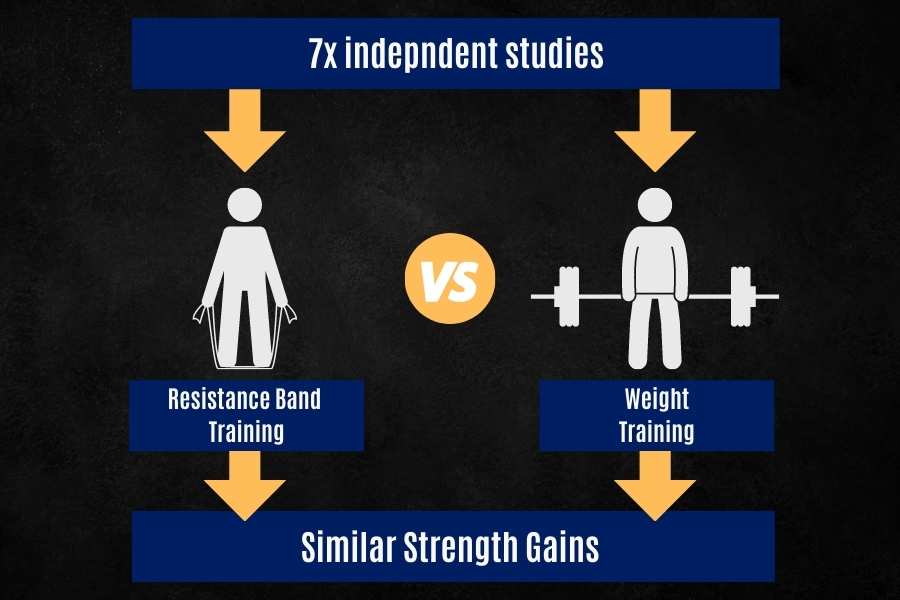
For example, this 2019 scientific review studied the results of 7 independent experiments comparing the strength gains between resistance bands vs conventional free-weight workout programs.
They found that resistance band training promoted a similar degree of strength development as traditional weight training.
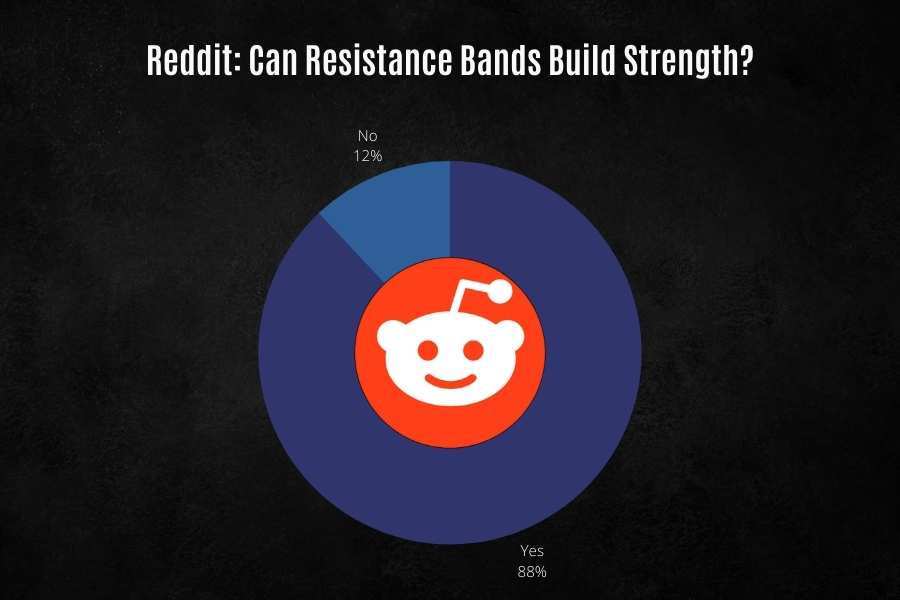
Additionally, 88% of this Reddit thread agreed that whilst resistance bands offer a different type of workout compared to free weights, bands alone were a good way for them to build strength.
Finally speaking from experience, I can tell you that bands can give you a killer workout.
I bench 260lbs (120kg) with a barbell and trust me when I say this- looping a couple of heavy bands around my torso whilst doing a push-up is almost as hard!
Now that’s out the way, we can find out what it is about resistance bands (their force profile) that make them ideal for strength training.
Why Resistance Bands Are An Effective Form Of Strength Training
Resistance bands are an effective form of strength training due to their unique tension profile. A band creates variable resistance where the tension increases as the band stretch. This makes them great for building strength in the top range of a movement.
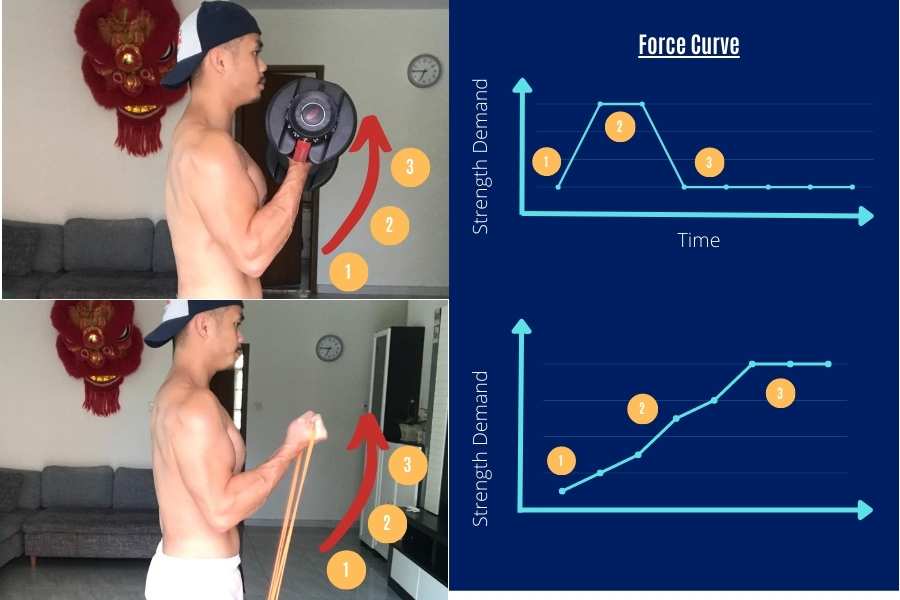
Let’s explore the concept of variable resistance using dumbbell vs band bicep curl examples:
- Dumbbell curl. You can see the movement is most difficult at the bottom. As the user goes through the range of motion, bicep tension actually decreases as the movement becomes easier.
- Band curl. You can see that movement is most difficult at the top. As the user goes through the motion, bicep tension increases and the movement becomes harder.
Therefore resistance bands force you to push harder near the top of an exercise
In non-band movements, the top portion is the easiest and consequently where the least strength is utilized.
You’ll know what this feels like if you’ve ever done a push-up or bench press.
It’s much easier to push during the bottom half of the movement compared to the top half right?
Well, resistance bands take that concept and completely flip it the other way around!
And this unique property of resistance bands creates a new stimulus for your muscles to adapt to by getting stronger.
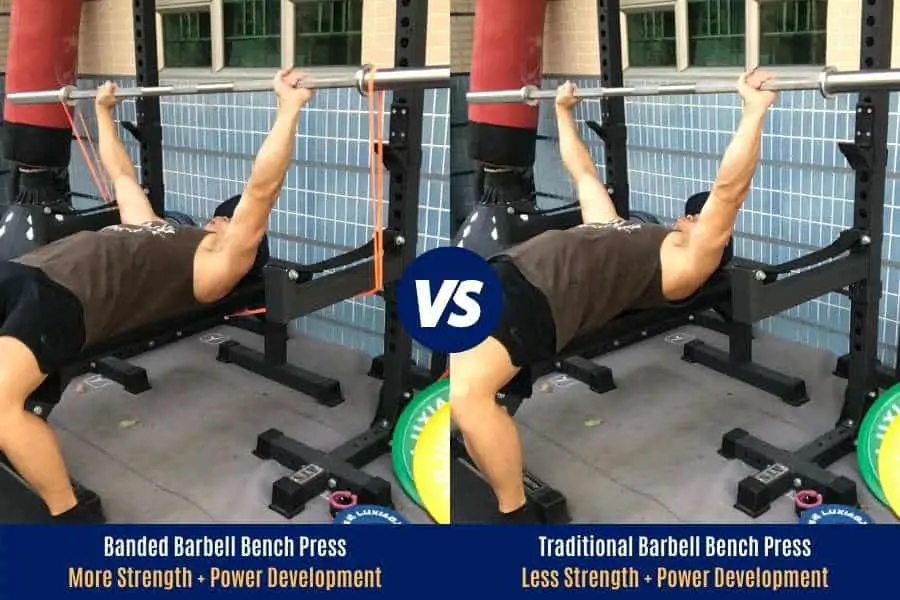
It’s this exact property of resistance bands that the scientists in this 2016 study credited for the increased bench press strength development in rugby players.
Here, they found that the players who trained with resistance bands developed a stronger bench press compared to those who trained with barbells.
If you’re new to resistance band training, you may be interested in my 15 resistance band exercise recommendations for beginners!
How To Increase Strength Using Resistance Bands
Here’s a detailed breakdown of how to build strength using resistance bands:
- Prioritize compound movements. These include all deadlifting, squatting, pressing, pulling, and rowing movements. These exercises utilize multiple muscle groups and help you to develop functional strength since they replicate everyday movements.
- Limit to 5-6 reps per set. This is known as the strength rep range. Working in low reps using a heavy resistance emphasizes strength development in your target muscles. It’s essential you use a heavy tension band though, and not use low reps as an excuse to do a low amount of work!
- Do not exceed 6 sets per muscle per workout. Working a muscle with more than 6 sets per workout has been shown to confer few added benefits, and leads to wasted sets. Save your time, effort, and energy by working smarter and not harder!
- Use a challenging band weight and regularly overload. Each set should fatigue your target muscle by the last rep. If it doesn’t, then you need to increase the weight. You should also increase weight every couple of weeks to keep your muscles adapting and getting stronger. A good set of resistance bands like the Undersun bands allow you to do this.
- Use a full range of motion. As you now know, bands produce most of their tension at the point of the highest stretch. So make sure you complete full reps!
- Eat enough protein and calories. I recommend a minimum of 1g of protein per lb of bodyweight and maintenance calories.
Next, I’ll factor all of these considerations into an example resistance band strength workout.
If you’re interested, you can check out my other post to learn more about the ideal number of repetitions and sets for band workouts!
Resistance Band Strength Workout Example
First, here’s an overview of how this resistance band strength training program works:
It’s a 3-day training split where you work the full-body each day.
It doesn’t matter which days you train.
But what does matter is that you give yourself between 1-2 full days of rest between workouts
This is ESSENTIAL!
Remember, your muscles get stronger on rest days. Therefore you need to give them the time they need to recover.
The reps and sets have been optimized for strength gains and remain the same throughout the week.
Each rep involves completing an explosive push/or pull with a full range of motion (ROM).
Next, I’ll share the exercises I recommend for each day.
Monday:
| Band Exercise | Reps | Sets | Rest Between Sets |
|---|---|---|---|
| Front squat with resistance band | 6 | 4 | 2-3 minutes |
| Resistance band push-up | 6 | 4 | 2-3 minutes |
| Back row with resistance band | 6 | 4 | 2-3 minutes |
| Banded core rotation | 6 | 4 | 2-3 minutes |
| Overhead shoulder press with bands | 6 | 4 | 2-3 minutes |
Wednesday:
| Band Exercise | Reps | Sets | Rest Between Sets |
|---|---|---|---|
| Resistance band deadlift | 6 | 4 | 2-3 minutes |
| Banded flat chest press | 6 | 4 | 2-3 minutes |
| Back row with resistance band | 6 | 4 | 2-3 minutes |
| Resistance band woodchop | 6 | 4 | 2-3 minutes |
| Overhead shoulder press with bands | 6 | 4 | 2-3 minutes |
Thursday:
| Band Exercise | Reps | Sets | Rest Between Sets |
|---|---|---|---|
| Front squat with resistance band | 6 | 4 | 2-3 minutes |
| Banded flat chest press | 6 | 4 | 2-3 minutes |
| Back row with resistance band | 6 | 4 | 2-3 minutes |
| Banded core rotation | 6 | 4 | 2-3 minutes |
| Overhead shoulder press with bands | 6 | 4 | 2-3 minutes |
Recommended Starting Weight:
Use a band weight that challenges you for 6 reps.
This will vary depending on your personal strength level and exercise.
So play experiment with different band weights to find the ideal resistance.
As a general rule, you should feel muscular fatigue (the “burn”) within the last 2 reps of each set.
If a set is too easy, then you should decrease the band weight.
Likewise, you should increase the band weight if a set is too hard to complete 6 reps.
How To Progress With This Resistance Band Strength Workout:
If you’re trying to get stronger using resistance bands, you must keep yourself challenged over time using progressive overload.
That’s because your muscles will naturally adapt to your current workload.
And if you don’t give them a novel stimulus, your strength gains will begin to plateau.
So here’s how you can apply progressive overload to your resistance band strength workout:
- Increase band weight. Start with the lighter bands and move on to heavy bands as you become familiar with each movement. Eventually, you might even outgrow the heavy bands (you can tell when 6 reps become easy). I would recommend combining multiple bands to further increase intensity. I use and recommend the Undersun resistance band set which is ideal for this!
- Increase range of motion. It’s normal for a beginner to lift resistance bands with a partial range of motion (ROM) at the beginning. That’s because the last few inches of stretch are tough. But this is what makes a resistance band so effective for building strength. So you should try to practice lifting with a full ROM as soon as you can! For example, when you do a banded press, make sure the arms fully extend!
- Increase the number of sets. This resistance band strength workout starts with 4 sets per exercise, which is great for beginners. But as you get stronger and fitter, you should increase to 5 sets when you feel ready, and even 6 sets eventually (no more than this).
Not sure what resistance bands can help you achieve? You may be interested in my other post which explains if resistance bands are better for building muscle or tone!
Can Resistance Bands Build Strength Like Weights?
Resistance bands are just as effective as weights for building muscle and getting stronger. They can be used for band-only exercises which do not require weights. Alternatively, they can also be looped around barbells and dumbbells to alter the force profile of these weights.
Earlier in this post, I shared a study that found that resistance bands were just as effective as weights in building bench press strength.
Furthermore, a much earlier 2014 study found that resistance bands produced similar muscle activation in a squat, compared to free weights.
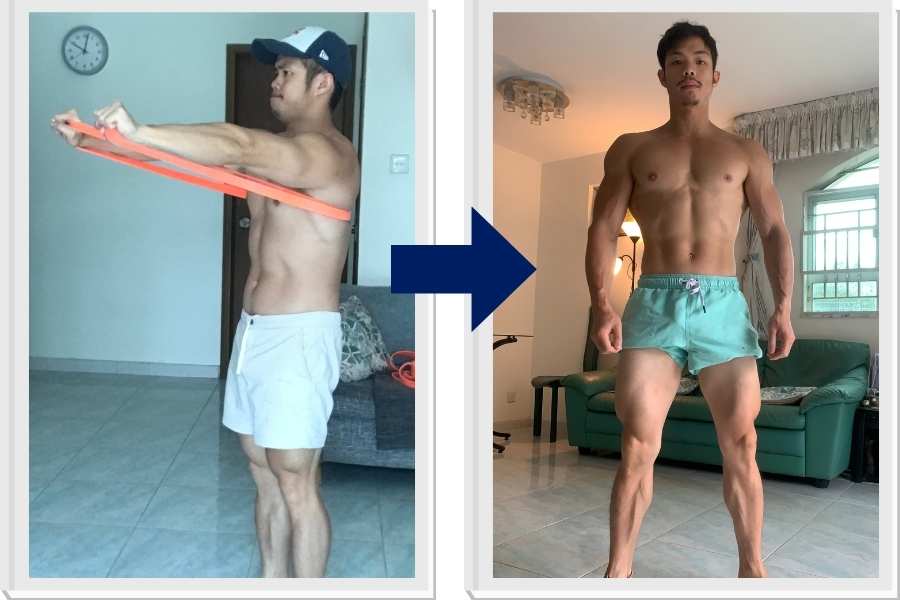
You may also be interested in my story for more evidence of the effectiveness of resistance bands:
I’ve been strength training in gyms for many years now. And the 2020 lockdown prevented me from following my usual training program which primarily revolved around the barbell and some dumbbell exercises.
So I decided to work exclusively with resistance bands at home.
Before the lockdown, I had started to plateau. I was struggling to add any further weight to my lifts.
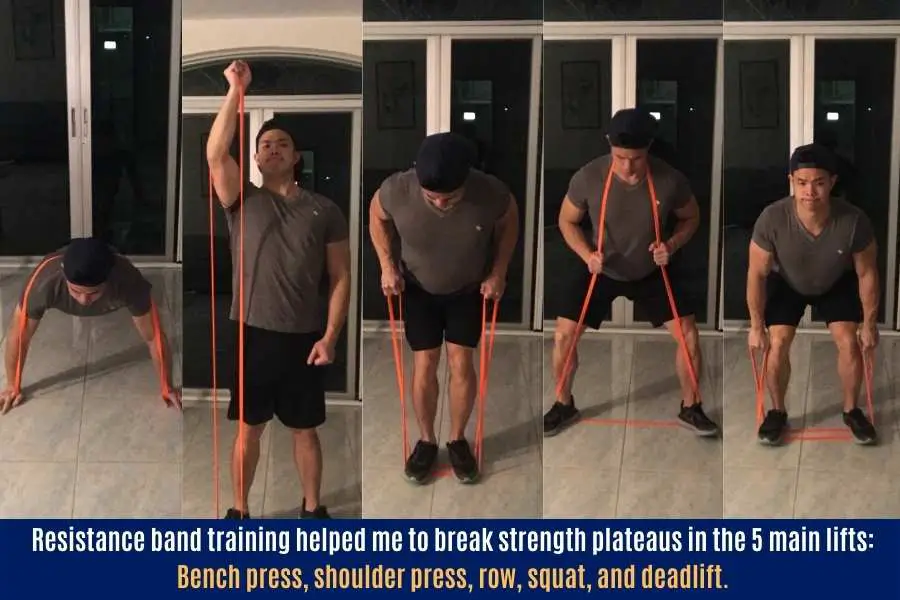
And guess what?
After the lockdown had passed (around 1 year of solid resistance band training), I came back stronger than I was before!
In the end, I broke my plateau and continued to build strength.
And I credit my resistance band training for this.
Just make sure you use a set of heavy resistance bands to challenge your muscles sufficiently, and you too should be able to build strength!
In my opinion, the Undersun bands are perfect for strength training.
If you’re new to band workouts, you may also be interested in my 10 essential tips for using resistance bands effectively at home!
Why The Undersun Bands Are Ideal For Strength Workouts
I’ve been using resistance bands for a total of 5+ years now.
And in this period, I’ve tried over half a dozen brands of resistance bands cheap and premium.
Out of all models I’ve tried, the Undersuns are the ones I’ve been using the longest and hands-down my recommendation.
The set contains 5 bands that go from extra light to extra heavy. This is ideal for people at different strength levels as well as for working for large and small muscle groups.

Additionally, all of the bands combined will provide you with enough resistance for years of strength progression.
And they are the only brand (as best I know) that provides a lifetime warranty.
You might also be interested in my other article to learn what weight means on a resistance band!
Conclusion
This post has explained why it’s possible to build strength using resistance bands and how to do it.
I’ve also shared an example of a full-body resistance band strength workout you can try as a beginner.
Whilst the unassuming nature of resistance bands can be deceptive, you shouldn’t be fooled.
The unique force profile of a band makes it an excellent tool for getting stronger.
Indeed, numerous scientific studies, as well as public case studies, have shown that resistance bands can be just as effective as weights for building strength.
Will you be trying to build strength using resistance bands?
Feel free to send me a message if you have any questions! You can find my details on the “contact us” page.
You may also be interested in the downloadable Kalibre Blueprint PDF which details exactly how I gained 40lbs of lean muscle (it’s 100% free!). It details the exact exercises and nutrition (with printable worksheets) I used to go from skinny to ripped!
Thanks for reading guys!
Peace Out,
Kal
(Biochemistry BSc, Biomedical Sciences MSc, Ex-Skinny Guy)


